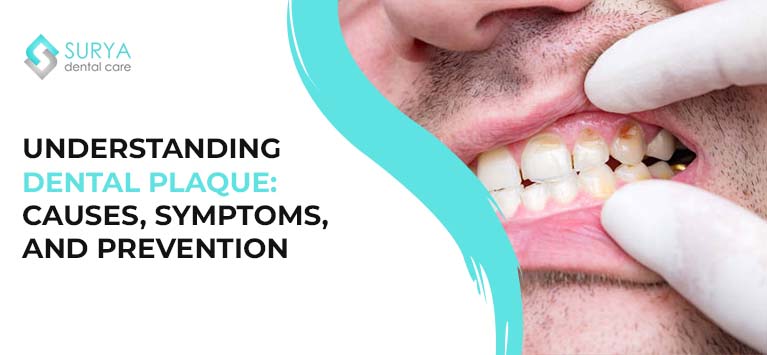The term plaque has many meanings and is able to evoke very different images, from the plates of the earth’s crust in geography to the metal plates that can be used in industrial processes. In medicine, however, the field narrows, especially if we limit ourselves to common parlance: there are plaques in the throat, and there is dental plaque. And it is precisely the latter, also known as bacterial plaque, that it is necessary to talk about on the website of a dental practice.
What is dental plaque?
Dental plaque is a biofilm of germs, a sticky and transparent substance, which colonizes the tooth surface and which, if not removed, can cause serious problems such as tooth decay, inflammation of the gums, and periodontitis.
From plaque to tartar
The transition from plaque to tartar occurs following a chemical reaction caused by the mineral salts present in saliva. The plaque calcifies and settles on the teeth in a solid state. Here is tartar, the main cause of serious dental diseases, such as tooth decay (or, worse, periodontitis ), or annoying disorders, such as bad breath.
Plaque detectors
To find the plaque present on the teeth and make an assessment (even at home) of the situation, it is possible to use so-called plaque detectors. These are non-toxic chemicals capable of coloring the plaque, making it red and, therefore, more visible. Their effect disappears with a simple rinse. They are available both in the form of liquids (especially for professional use) and in tablets.
Symptoms of dental plaque
When plaque appears, the enamel changes its color; for example, it becomes more yellowish, its surface loses its shine, and the tooth looks as if it is covered with a loose mass. Bad Breath is also characteristic. When feeling the teeth with the tongue, patients note their roughness. First of all, plaque accumulates in places inaccessible to natural cleansing, for example, in the cervical area.
The color of plaque can be different; for example, green plaque appears due to the development of microbes containing chlorophyll. It is usually observed in children and young people. It is localized on the vestibular surface of the teeth, spreading over the enamel in a thin layer.
Adults often develop a brown plaque; its causes may be:
- Smoking.
- Contact with harmful labor factors – copper, brass, bronze. Copper amalgam fillings can also cause plaque.
- In children, brown or black plaque can be caused by treatment with iron supplements when the doctor’s recommendations are not followed, and it is taken in excess.
Diagnosis of dental plaque
You can determine the accumulation of plaque yourself using a regular mirror. In the dentist’s office, it is determined using special dyes that allow better visualization of deposits invisible to the eye. An iodine solution, methylene blue, eosin, fuchsin, or lugol solution is used. After staining, a quantitative assessment of the extent of plaque spread is carried out and oral hygiene indices are calculated.
Fighting plaque at home
The main reason why hard plaque and tartar form is an insufficient level of home hygiene. At the same time, home hygiene is the best prevention of the appearance of hard plaque.
How to remove plaque at home?
- Brush your teeth on a regular and thorough basis, at least twice a day, using a soft-bristled toothbrush and toothpaste. Brushes or floss should be used to clean the interdental gaps. You may use the irrigator after meals during the day. If you have orthodontic structures or implants, crowns, or persistent periodontal disorders, your doctor may advise you to broaden your home care items and practices. For example, Brush your teeth using a single-tuft brush in addition to a standard one.
- Use foamy mouth rinses. They will reduce the number of bacteria in the mouth and reduce the rate of plaque formation. Many act comprehensively: strengthen enamel, help prevent caries, and freshen breath.
- Limit your consumption of sweets. Excess sugar in food is a haven for pathogenic microflora in the oral cavity. They eat until they are full and then secrete acid, which destroys the enamel. It is worth reducing the consumption of baked goods, sweets and candies, and sweet soda. But there should be as many fresh vegetables and fruits in the diet as possible. Chewing a carrot or an apple also aids in plaque prevention. They are also high in vitamins and minerals, which are essential for good dental health.
What is added to anti-plaque pastes and rinses?
Many toothpastes and rinses contain ingredients that help fight plaque.
Abrasives
This is the name given to the solid particles in toothpaste that help remove plaque from the enamel. Choose pastes with soft abrasives (silicon dioxide, bentonite). They delicately remove plaque without damaging the enamel.
Pyrophosphates
Pyrophosphates prevent the mineralization of dental plaque; that is, they prevent it from turning into tartar.
Enzymes
Some anti-plaque toothpastes add enzymes that saliva naturally contains. They break down plaque and bacteria living in it.
Zinc citrate
Both on its own and in combination with sodium lauryl sulfate, zinc inhibits the growth of pathogenic bacteria in the oral cavity.
Sodium citrate
This component reduces acidity in the oral cavity and prevents the harmful effects of bacteria, demineralization of enamel, and caries.
How do you know if there is too much plaque and it’s time to see a doctor?
If plaque forms too intensely, you may notice the following signs:
- bad breath;
- the feeling of stickiness on the surface of the teeth;
- yellowish, grayish, or black plaque on the teeth;
- bleeding and increased sensitivity of the gums.
If you cannot completely remove plaque on your own, and after cleaning the plaque stains more than half of the surface of the teeth, you should visit a dentist. He will perform professional oral hygiene, adjust your brushing technique, and recommend additional home care products.



